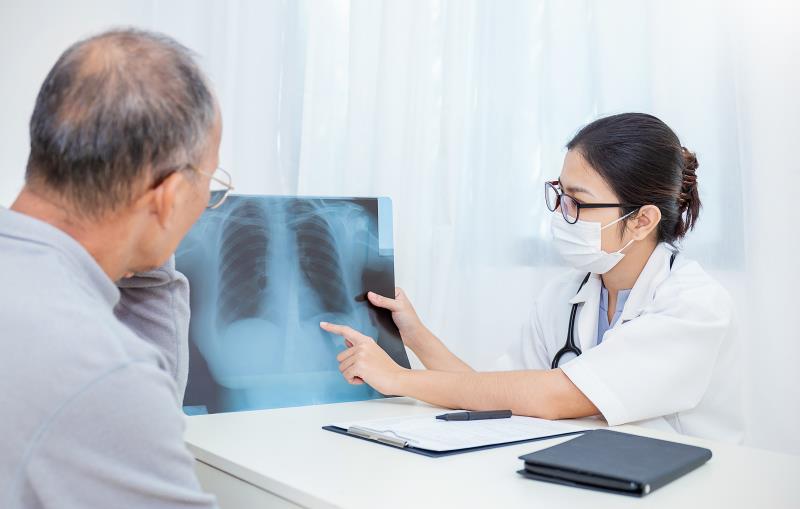Flat-dose nivolumab well-tolerated, active for advanced NSCLC in Asians





Flat-dose nivolumab, administered as a 30-minute infusion, is well tolerated and active in Asian patients with previously treated advanced non-small-cell lung cancer (NSCLC), according to results of the phase IIIb CheckMate 870 study.
In the open-label, single-arm study, 400 patients (median age, 61 years; male, 78.5 percent) with stage IIIB/IV NSCLC previously treated with 1–2 prior systemic therapies received flat-dose nivolumab monotherapy (240 mg in 30-minute infusion, Q2W). The study’s population was predominantly Chinese (98.5 percent). Most patients had nonsquamous (66.0 percent) histology, and were without EGFR mutations (65.3 percent) or ALK translocations (70.5 percent). A similar proportion of patients had PD-L1 ≥1 percent (42.3 percent) or <1 percent (43.5 percent). [Lu S, et al, AACR 2020 Virtual Meeting II, abstract CT218]
Of note, the study also included patients with hepatitis B virus (HBV) infection (4.25 percent), who were often excluded in prior NSCLC clinical trials.
Patients in the study received flat-dose nivolumab monotherapy for a median of 3.2 months. High-grade (grade ≥3) treatment-related select adverse events (AEs) in non–HBV infected patients, the primary endpoint, were most commonly hepatic (2.3 percent), skin (1.6 percent), pulmonary (1.0 percent), and endocrine (0.8 percent) events.
“Within each treatment-related select AE category, individual grade 3/4 events were reported in ≤0.8 percent of non–HBV infected patients. Grade 3/4 events reported in >1 patient were increased gamma glutamyltransferase, rash [n=3 each], diabetes mellitus, increased blood alkaline phosphatase, diarrhoea, and interstitial lung disease [n=2 each],” the investigators reported. “No grade 5 treatment-related select AEs were reported in non–HBV infected patients.”
In patients with HBV infection, no grade 3–5 treatment-related select AEs were reported.
“The safety profile of nivolumab was similar across non–HBV infected and HBV-infected patients,” the investigators noted.
Overall, grade 3/4 treatment-related AEs (TRAEs) occurred in 12.8 percent of all patients, with hyponatraemia (2 percent) and lung infection (1 percent) being the most common. TRAEs led to treatment discontinuation in 2.0 percent of the patients. Two treatment-related deaths resulting from myocarditis (non–HBV infected patient) and lung infection (HBV-infected patient) were reported.
At a median follow-up of 9.6 months, median overall survival (OS) was not reached, while the 6-month OS rate was 75 percent among all treated patients.
Six-month OS rates were 75 percent vs 82 percent in non–HBV infected vs HBV-infected patients, 76 percent vs 72 percent in patients with nonsquamous vs squamous histology, and 77 percent vs 74 percent in patients with PD-L1 ≥1 percent vs <1 percent. In patients with EGFR-positive tumours, EGFR-negative tumours and unreported EGFR mutation status, 6-month OS rates were 85 percent, 74 percent and 75 percent, respectively.
Median progression-free survival (PFS) and 6-month PFS rate were 3.7 months and 34 percent, respectively, among all treated patients. The overall response rate (ORR) was 62 percent, with a median time to objective response of 1.9 months and a median duration of response of 9.5 months.
“A numerical improvement in ORR was observed in patients with PD-L1 ≥1 percent [24.8 percent vs 8.6 percent in patients with PD-L1 <1 percent],” the investigators reported.
“Our findings are consistent with prior clinical experience with nivolumab 3 mg/kg, administered as a 60-minute infusion in pivotal trials in second-line, advanced NSCLC, and with prior clinical experience in a global trial of flat-dose nivolumab for NSCLC,” the investigators concluded. [J Thorac Oncol 2019;14:867-875; N Engl J Med 2015;373:123-135; N Engl J Med 2015;373:1627-1639; J Clin Oncol 2017;35:3924-3933; Garon E, et al, ASCO-SITC Clinical Immuno-Oncology Symposium 2019, poster 100] “No new safety signals were identified in this study.”